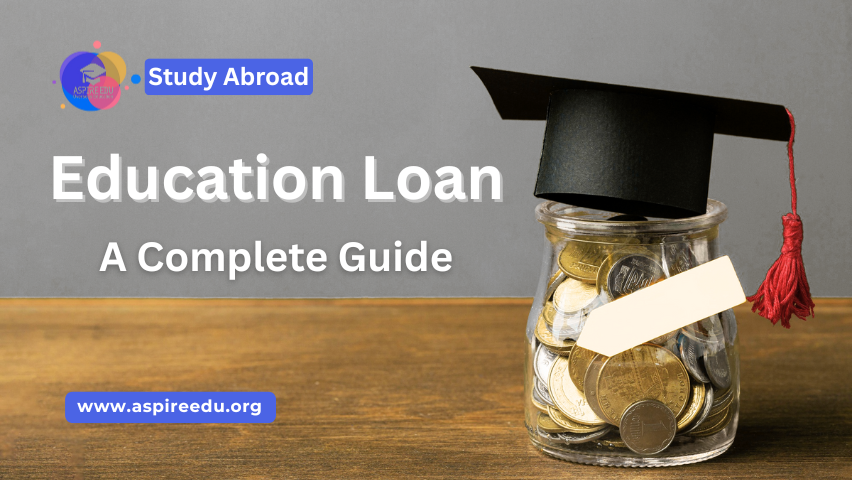Introduction
Pursuing higher education abroad is a dream for many students, but the high cost of tuition fees, accommodation, and living expenses can be a major hurdle. An education loan for abroad studies can help bridge this financial gap, allowing students to focus on their academic goals without financial stress.
In this guide, we’ll explore everything you need to know about securing an education loan for studying overseas—from eligibility criteria to repayment options.

What is an Education Loan for Foreign Studies?
An education loan for abroad studies is a financial product offered by banks and NBFCs (Non-Banking Financial Companies) to help students cover expenses related to international education. This includes:
– Tuition fees
– Accommodation & living costs
– Travel expenses
– Study materials & equipment
– Insurance & other miscellaneous expenses
These loans typically come with flexible repayment options, including a moratorium period (a grace period after course completion before repayment begins).
Benefits of Availing an Education Loan
Taking an education loan for studying abroad comes with several advantages:
No Need for Immediate Funds – Students can pursue their dreams without worrying about upfront payments.
Tax Benefits – Under Section 80E of the Income Tax Act, borrowers can claim deductions on interest paid.
Flexible Repayment Terms – Most lenders offer a moratorium period (6-12 months after course completion).
Competitive Interest Rates – Lower compared to personal loans, with options for fixed or floating rates.
Builds Credit History – Timely repayments improve credit score, helping in future financial needs.
Eligibility Criteria for Applying for an Education Loan
While eligibility varies by lender, common requirements include:
Academic Qualifications – Admission to a recognized foreign university/institution.
Course Type – Degree, diploma, or certification programs (some lenders may have restrictions).
Age Limit – Typically between 18-35 years.
Co-applicant Requirement – Parent/guardian with a stable income may be needed.
Collateral (if applicable) – For loans above ₹7.5 lakhs, lenders may ask for property/FD as security.
Types of Study Loans Available
1. Secured Education Loans
A secured education loan is an excellent option for students needing substantial funding for abroad studies. With lower interest rates, higher loan amounts, and flexible repayment, it eases financial burdens while keeping future repayment manageable.
– Requires collateral (property, fixed deposits, etc.).
– Higher loan amounts (up to ₹1.5 crores or more).
– Lower interest rates.
2. Unsecured Education Loans
An unsecured education loan is an excellent choice for students who need financial support for studying abroad but do not have collateral to pledge. With benefits like quick approval, no asset risk, and flexible repayment options, it provides a convenient way to fund your international education without the stress of securing high-value collateral.
– No collateral needed.
– Loan amounts usually up to ₹40-50 lakhs.
– Slightly higher interest rates.
3. Government-Backed Loans
Government-backed education loans offer a secure and affordable pathway for Indian students aspiring to study abroad. With lower interest rates, flexible repayment terms, and borrower-friendly policies, these schemes make international education accessible to deserving candidates from all financial backgrounds.
– Schemes like Vidya Lakshmi provide subsidized loans.
– Lower interest rates for meritorious students.
4. Loans from NBFCs & Private Lenders
For students seeking quick and hassle-free education loans, NBFCs (Non-Banking Financial Companies) and private lenders offer a convenient alternative to traditional bank loans. With faster approvals, flexible eligibility criteria, and customized loan solutions, these lenders have become a popular choice for funding overseas education.
– Faster approval but higher interest rates.
– Flexible eligibility criteria.
Important Points to Remember
Compare Interest Rates – Check offers from multiple banks/NBFCs.
Check Processing Fees & Hidden Charges – Some lenders impose additional costs.
Moratorium Period – Understand when repayments start.
Forex & Currency Fluctuations – If the loan is in foreign currency, exchange rates may impact repayment.
Scholarships & Grants – Apply for scholarships to reduce loan dependency.
Loan Repayment Plans – Choose between EMI options (step-up, step-down, etc.).
Conclusion
An education loan for abroad studies can be a game-changer for students aspiring to study overseas. By understanding eligibility, loan types, and repayment terms, you can make an informed decision and secure the best financial support for your education.
